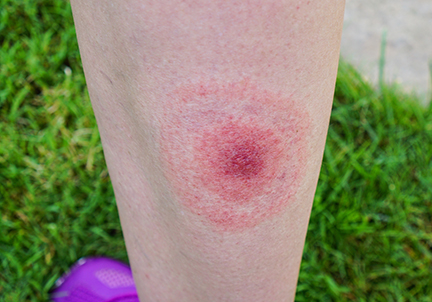Don’t let summer tick you off
Lyme disease cases are on the rise across the United States. Stay protected.
Article Date:

Summer: a time to shed our winter layers and step out into the warm sunshine to take in the rivers and lakes and beaches, the hiking trails and camp sites, the community parks and sports fields — and also a time to watch out for the pesky critters that come out on all the adventures with us.
“Wait, what? Bugs?” you ask. “Who wants to spend summer worried about bites and stings?”
The hot, humid temps are great for backyard picnics and outdoor activities, but they are also the perfect conditions for black-legged ticks. These creatures, carriers of Lyme disease, are more prevalent in the summer than any other time of the year.
According to the U.S. Centers for Disease Control and Prevention (CDC), cases of tick-borne diseases more than doubled from 2004 to 2016 – from 22,000 to 48,000 cases – with Lyme disease accounting for 82 percent of them. Worst of all, due to under-reporting, the numbers are actually expected to be much higher — trending closer to 350,000 in 2016.
The majority of cases were reported in northern states like Maine, Delaware, New Jersey and Vermont. The CDC, however, says there’s one small hitch: occasionally diseases can be reported in a state where it was not acquired.
Brian Granger, DO, a Baptist Primary Care family physician, checks his patients for Lyme disease any time an individual shows symptoms of fatigue, tingling or numbness of extremities.

One of the most obvious signs of Lyme disease is the circular rash, he said — almost like a halo around the tick bite. However, that doesn’t have to be present for someone to be infected with the bacterium that causes Lyme.
Untreated Lyme disease can include a variety of complications, such as encephalitis, a brain infection; myocarditis, a heart infection; or endocarditis, a heart valve infection. People can also develop chronic fatigue syndrome, a disorder that causes extreme tiredness that doesn’t go away with rest, Dr. Granger said.
Can these consequences be long term?
Unfortunately, yes, they can.
But here’s the good news: The risk of acquiring a tick-borne infection is still actually pretty low. Ticks transmit bacteria only after they have attached and taken a meal from their new host. The deer tick that usually carries the Lyme bacterium typically feeds for up to 36 hours before transmission, placing the risk of Lyme disease around 2 percent.
To reduce your risk of a bite, Dr. Granger recommends wearing long pants and sleeves when venturing into the woods.
“Make sure your clothes are white or khaki so you can easily spot ticks and then frequently check for them on your clothing and on your skin,” he added. “If you are bitten by a tick, you should contact your doctor and get tested, even if you don’t have a rash.”
If you get diagnosed with Lyme disease, the standard of care recommended by the CDC is 10 to 21 days of doxycycline, an oral antibiotic. Dr. Granger says after those two to three weeks, he would want to see the patient again to verify the Lyme disease is gone.
“There is still some debate about treatment and how long Lyme disease can last in individuals,” he said. “Just make sure to be aware of how you feel and communicate that with your doctor. If you’re going to google about Lyme disease, make sure you are checking a reputable source.”
Source: Centers for Disease Control



